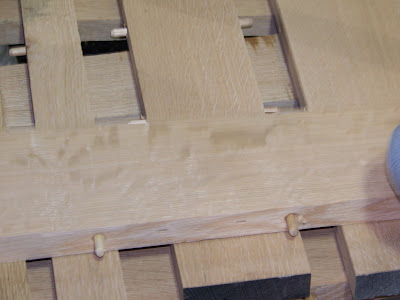 The process of picking and processing the woods that add the aging nuances to the best whiskies is a painstaking one.
The process of picking and processing the woods that add the aging nuances to the best whiskies is a painstaking one. I had the opportunity to observe it, from the felling of white oak trees in a Missouri forest to seeing the finished barrels coming off the line in a Kentucky cooperage as part of an assignment for Whisky magazine, the UK publication that is the leading such magazine in the world.
You'll have to pick up a copy of the magazine to read the story, but I can share with you this pictorial timeline I shot that shows the process:
INTO THE FOREST PRIMEVAL

(1.) An overcast early spring day in the Ozark Mountains of Missouri near Mark Twain’s boyhood hometown of Hannibal. This view from Victors Point shows a double-bend in the Mississippi River and a still-bleak countryside.

(2.) Dr. Bill Lumsden, head of distilling and whisky creation for Glenmorangie, gestures to Bob Russell, left, head of Brown-Forman sawmill operations, during a meeting with representatives of the Missouri Conservation Dept. They were setting up a tree-felling session on a state-owned Ozarks tract that is one of Brown-Forman’s suppliers of white oak for barrel making.

(3.) Lumberjacks Jerry (left) and Eddie Hicks, brothers who have been logging in the Ozark Mountains for more than two decades, meet with Missouri Conservation Dept. Resource Forester Kristen Goodrich to review red-marked trees scheduled for felling in the Edward Anderson Conservation Area forest near Hannibal, Missouri.

(4.) Stripes of red paint designate which American white oak trees are to be cut down.

(5.) Logger Jerry Hicks goes to work cutting down one of the designated oak trees.

(6.) The Hicks brothers go to work dissecting the fresh-cut oak.

(7.) A rough end of the new-cut tree gets trimmed off to reveal the best portion of the heart.

(8.) This cross-section of the newly-felled oak shows good composition.
ON TO THE SAWMILL

(9.) Leroy Cardwell, left, owner of the Cardwell Lumber Inc. sawmills in Novelty, Missouri, and two other towns, discusses the latest shipment with Bob Russell and Bill Lumsden.

(10.) Graded oak logs are stored outside the Cardwell sawmill to await being sawn and shaped into staves for wine and spirits barrels.

(11.) A worker guides quarter-sawn logs into a shaping device.

(12.) Faint diagonal saw marks across the grain of the staves is the desired cut to prevent splitting under pressure.

(13.) Amish workers, with the straw hats and beards their religion dictates, make up a large part of the Caldwell sawmill work force.



(14a, 14b, 14c) Workers at this station, guided by a laser marker, fit odd-sized wood scraps together to create pressure-fitted tongue-in-groove squares. The rough squares then are cut into circular shapes for the tops and bottoms of the barrels.
AND THEN TO THE COOPERAGE

(15.) Workers known as “barrel raisers” assemble 32 staves into barrels.



(16a, 16b, 16c) As part of the process of a zero-waste manufacturing stream, some scrap wood is made into dowel pegs to hold together barrel headers.

(17.) Barrel headers are coated with beeswax, then run through a charring apparatus.


(18a, 18b) Finished charred headers are stacked up until the remainder of the barrels come off the assembly line.

(19.) Meanwhile, the barrels are “toasted.” Wood begins to ignite at 482°F, creating a controlled char of the inside of each barrel.

(20.) Once barrels are fully processed, they are put on conveyer belts and head for their final destinations.
To Dowd's Spirits Notebook latest entry.
To Dowd's Wine Notebook latest entry.
To Dowd's Brews Notebook latest entry.
To Dowd's Non-Alcohol Drinks Notebook latest entry.
To Dowd's Tasting Notes latest entry.
Back to Dowd On Drinks home page.
No comments:
Post a Comment